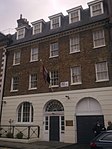University Women's Club
1883 establishments in EnglandAC with 0 elementsBuildings and structures in MayfairEnglish organisation stubsGentlemen's clubs in London ... and 5 more
Organizations established in 1883Source attributionWomen's clubsWomen's organisations based in EnglandWomen in London

The University Women's Club, originally the University Club for Ladies, is a British private members club founded in 1883. As the popular gentlemen's clubs did not accept any women as members, its creation was intended to provide an equivalent club accessible to women. By its own definition, it is a club for "graduate and professional women of varied backgrounds and interests". Members include lawyers, scientists, writers and musicians, as well as businesswomen. The club house is located at 2 Audley Square, on South Audley Street, Mayfair, London.
Excerpt from the Wikipedia article University Women's Club (License: CC BY-SA 3.0, Authors, Images).University Women's Club
Audley Square, City of Westminster Mayfair
Geographical coordinates (GPS) Address Website External links Nearby Places Show on map
Geographical coordinates (GPS)
| Latitude | Longitude |
|---|---|
| N 51.5073 ° | E -0.1507 ° |
Address
University Women's Club
Audley Square 2
W1K 1DB City of Westminster, Mayfair
England, United Kingdom
Open on Google Maps










